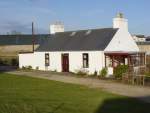|
The Picts
The stones used to build Latheron Mains barn and the surrounding wall are said to have come from the “Chapel Stones” (see below). Latheron shows no evidence of Viking or Late Norse population, which was concentrated further North in Caithness, as can be seen from place names in these areas. In the Middle Ages the revenue of the Parish of Latheron (the largest parish in Caithness) was assigned along with Reay, Thurso and Wick to the Bishop of Caithness. Records from 1275 show that Lagheryn contributed towards the cost of Crusade. (In spite of the size of the parish there was originally only one church situated in the hamlet of Latheron, this catered for the whole of the parish, see below). Other references to Latheron include the records of the itinerary and expenses of the messengers sent by Edward I to meet Margaret, the ‘Maid of Norway’, and the grand-daughter of Alexander III who drowned in 1290 off the coast of Orkney on her way to Scotland to journey to marry King Edward 1. The messengers spent the night of 2nd October 1290 at Helmsdale and that of the 3rd at a ‘Hospital’ before riding on to Wick on the 4th. It is unlikely that the hospital was the hospital of Spittal. Whilst Tim Blackie and Colin Macaulay were investigating the stones at Latheron they were informed that the stones used to build the barn called the West Byres at Latheron Mains came from the ‘Chapel Stones’ site to the east of Latheron Mains farmhouse. This site shows an approx. 40 m long line of massive foundation stones, it was identified as a cairn in Dr Batey’s survey (1980-82, 1980) but the size, alignment and regularity of the stones show that these are dressed stones from the lower course of substantial building. One stone at the site appears to bear evidence of carving in the form of moulded ridges. Blackie and Macauley found an unpublished paper by a local clergyman (W.G. Mowat, The Church in Latheron Parish) that gives a sketch of the site and states it is ‘thought to be the remains of an abbey’. A hospital/hospice at Latheron would have fitted in perfectly with the itinerary of the party travelling from England, as the journey times from Helmsdale to Latheron, Latheron to Wick would have been approximately the same. 1. Source: The Sculptured Stones of Caithness, Tim Blackie and Colin Macaulay, The Pinkfoot Press, 1998 |

